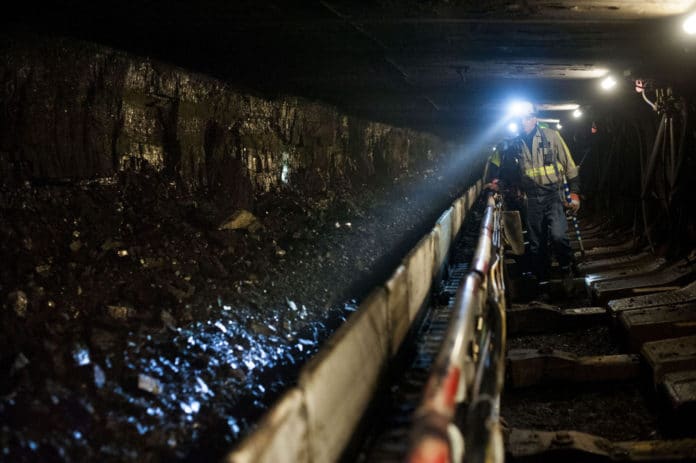Plummeting coal prices have pushed almost half the debt issued by U.S. coal companies into default, and for miners and their investors there’s no end in sight.
Patriot Coal, Walter Energy and Alpha Natural Resources have all filed for bankruptcy in the past year. Now that Arch Coal, the second largest coal miner in the U.S., has joined their ranks, investors are wondering if the biggest, Peabody Energy, could be next.
Peabody’s shares have been sliced roughly in half since Arch filed for Chapter 11 on Jan. 11. The company’s 6.5 percent unsecured bonds have lost 27 percent, or 3.1 cents on the dollar, over the same period, most recently trading on Jan. 14 at 8.6 cents and yielding 99 percent, according to Trace, the bond-price reporting system of the Financial Industry Regulatory Authority.
“Lots of people are wondering: What’s the next shoe to drop? Who might be the next company? Peabody’s on everybody’s list,” said Spencer Cutter, a Bloomberg Intelligence analyst in Skillman, New Jersey, in a webcast presentation about the global coal industry on Jan. 14.
Coal producers are suffering through a historic rout. Over the past five years, the industry has lost 94 percent of its market value, from $68.6 billion to $4.02 billion.
In addition, Fitch Ratings said in a Jan. 11 report that Arch’s bankruptcy pushed the sector’s default rate to “an unprecedented peak” of 43 percent. So investors are now raising questions about the viability of other miners, such as Consol Energy, Foresight Energy, Cloud Peak Energy and Murray Energy.
“This once-mighty industry is destined to gradually shrink in importance, and virtually disappear as an investable sector,” said Margie Patel, a portfolio manager with Wells Fargo Asset Management in Boston, which manages $351 billion.
Peabody and Arch were among the miners that raised a total of $6.4 billion of debt in 2010 and 2011, betting that prices for metallurgical coal, which is sometimes used to produce steel, would continue to rise thanks to China’s growing demand to build its cities. After reaching $330 per metric ton in 2011, prices have since tanked to a quarter of that level. Goldman Sachs forecasts benchmark metallurgical coal prices to fall to $75 this year.
Peabody has been working on a debt exchange with its lenders since last year, but has yet to agree to a deal — Arch tried a similar tact before it went under and failed, accelerating its demise.
In terms of capital, Peabody had $1.4 billion in liquidity including cash and availability under its revolving loans as of Nov. 5, according to a company filing. Its cash dropped to $167.4 million on that day from $334.3 million at the end of September. At that rate, the company has about nine months before it runs out of cash.
Peabody’s cushion will be pressured with coal prices so low. Its interest expenses are more than its cash on hand, according to Bloomberg data. For the 12 months ended Sept. 30, it burned through $445 million. At that rate, the company is going to run out of cash in nine months, Bloomberg data show.
“In a challenging market backdrop, Peabody continues its aggressive efforts to improve the business with a major focus on operational, portfolio and financial initiatives,” Peabody spokeswoman Beth Sutton said via e-mail. “Our dual financial objectives are to optimize liquidity and deleverage, and we continue to pursue multiple actions on this front.”
If Peabody files for Chapter 11, it will have plenty of company among its competitors. In less than two years, as many as five coal miners have filed for bankruptcy to restructure a total of $22 billion in debt, according to data compiled by Bloomberg.
James River Coal filed for bankruptcy in April 2014 to restructure its $819 million in debt. Patriot Coal, which emerged from Chapter 11 at the end of 2013, filed again in May. Walter Energy and Alpha Natural, two of the biggest metallurgical coal producers in the U.S., filed in July and August with a combined total of $12.1 billion in debt.
In addition, Cliffs Natural Resources sold its coal business to Seneca Coal Resources for $268 million in December. Lourenco Goncalves, Cliffs’ chief executive officer, explained in a statement that the sale was made “in light of the many headwinds the industry has faced over this past year.”
Consol spokesman Brian Aiello and Cloud Peak spokesman Rick Curtsinger didn’t respond to requests for comment. Gary Broadbent, spokesman for both Murray and Foresight, declined to comment.
While there’s plenty of uncertainty surrounding the coal business, there is one thing that traders and industry insiders agree on: There won’t be a rebound anytime soon.
“The world of coal will be very ugly in 2016,” said Ted O’Brien, chief executive officer at Doyle Trading Consultants, an independent consulting firm specializing in metals and mining. “All the bankruptcy filings that took place only helped on paper. It didn’t take away supply in the markets.”






